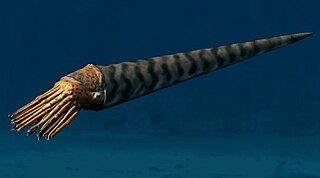
Endocerida is an extinct nautiloid order, a group of cephalopods from the Lower Paleozoic with cone-like deposits in their siphuncle. Endocerida was a diverse group of cephalopods that lived from the Early Ordovician possibly to the Late Silurian. Their shells were variable in form. Some were straight (orthoconic), others curved (cyrtoconic); some were long (longiconic), others short (breviconic). Some long-shelled forms like Endoceras attained shell lengths close to 6 metres (20 ft). The related Cameroceras is anecdotally reported to have reached lengths approaching 9 metres (30 ft), but these claims are problematic. The overwhelming majority of endocerids and nautiloids in general are much smaller, usually less than a meter long when fully grown.

Orthoceratidae is an extinct family of actively mobile carnivorous cephalopods, subclass Nautiloidea, that lived in what would be North America, Europe, Asia, Africa, and Australia from the Ordovician through Triassic from 490—203.7 mya, existing for approximately 286.4 million years.
The Ellesmerocerida is an order of primitive cephalopods belonging to the subclass Nautiloidea with a widespread distribution that lived during the Late Cambrian and Ordovician.
Michelinoceras is the oldest known genus of the Michelinocerida, more commonly known as the Orthocerida, characterized by long, slender, nearly cylindrical orthocones with a circular cross section, long camerae, very long body chambers, and a central or near central tubular siphuncle free of organic deposits. Septal necks are straight; connecting rings cylindrical and thin. Cameral deposits are well developed. A radula has been found in one species, with seven teeth per row. It had ten arms, two of which formed longer tentacles.

The Ellesmeroceratidae constitute a family within the cephalopod order Ellesmerocerida. They lived from the Upper Cambrian to the Lower Ordovician. They are characterized by straight and endogastric shells, often laterally compressed, so the dorso-ventral dimension is slightly greater than the lateral, with close spaced sutures having shallow lateral lobes and a generally large tubular ventro-marginal siphuncle with concave segments and irregularly spaced diaphragms. Connecting rings are thick and layered, externally straight but thickening inwardly with the maximum near the middle of the segment so as to leave concave depressions on internal siphuncle molds. Septal necks are typically orthochoanitic but vary in length from almost absent (achoanitic) to reaching halfway to the previous septum (hemichoanitic) and may even slope inwardly (loxochoanitic).
Wardoceras is an extinct nautiloid genus from the late Early Ordovician of Western Utah, assigned to the orthocerid family, Michelinoceratidae
Baltoceratidae is an extinct family of orthoconic cephalopods belonging to the subclass Nautiloidea endemic to what would be Asia, Australia, Europe, North America, and South America during the Ordovician living from about 480–460 mya, existing for approximately 20 million years.

Geisonoceratidae is an extinct family of orthoceroid cephalopods endemic to what would be Asia, Europe, and North America from the Middle Ordovician to the Middle Devonian living from about 470—380 mya, existing for approximately 90 million years. With the possible addition of an Early Cretaceous orthocerid from the western Caucasus the range of this group increases dramatically to some 350 million years, thus making it one of the longest lived families of the Nautiloidea.

Proteoceratidae is an extinct family of actively mobile aquatic carnivorous cephalopods belonging to the subclass Orthoceratoidea endemic to what would be Asia, Australia, Europe, South America and North America during the Ordovician living from 490—445.6 Ma, existing for approximately 44.4 million years.
Endorioceras is an extinct genus of actively mobile carnivorous cephalopod of the family Baltoceratidae that lived in what would be North America during the Ordovician from 490–479 mya, existing for approximately 11 million years.
Rioceras is an extinct genus of orthocerid cephalopods of the family Baltoceratidae that lived in what would be North America during the Early Ordovician from 480—472 mya, existing for approximately 8 million years.
Rhabdiferoceras is an extinct genus of orthocerids belonging to the Baltoceratidae that lived in what would be North America during the Cassinian Stage at the end of the Early Ordovician, existing for approximately two million years from about 474 -472 mya.

Orthoceratoidea is a major subclass of nautiloid cephalopods. Members of this subclass usually have orthoconic (straight) to slightly cyrtoconic (curved) shells, and central to subcentral siphuncles which may bear internal deposits. Orthoceratoids are also characterized by dorsomyarian muscle scars, extensive cameral deposits, and calciosiphonate connecting rings with a porous and calcitic inner layer.
Tajaroceras is an extinct slender cephalopod from the uppermost Lower Ordovician of western North America, belonging to the Orthocerid family Troedssonellidae.

Troedssonellidae is a family of orthoceroid cephalopods from the Ordovician, derived from rod-bearing Baltoceratidae, that have a continuous lining within the siphuncle that resembles very thin and slender endocones. Shells are generally slender and orthoconic. The siphuncle is central or subcentral, composed of straight or slightly expanded segments. Septal necks generally short and connecting rings are thin. Thin cameral deposits are known, which along with the position of the siphuncle and thin connecting rings distinguishes them from the endocerids in which they have been included.

Endoceratidae is a family of large to very large straight shelled nautiloid cephalopods belonging to the order Endocerida that lived during the Middle and Late Ordovician. They include the largest known Paleozoic invertebrates, represented by Endoceras and Cameroceras.
Dissidocerida is an order of Early Ordovician to the Early Silurian orthoceratoid cephalopods in which the siphuncle has a continuous lining or a longitudinal rod-like structure within.
Rangeroceras is an extinct orthoceratoid cephalopod genus that lived in what is now western North America during the latter part of the Early Ordovician.
Veneficoceras is a genus of the rod-bearing Baltoceratidae, an extinct cephalopod family with characteristics of the orthoceratoid Dissidocerida, found in Cassinianage, Lower Ordovician, limestone in western Utah.
Apocrinoceratidae constitutes a family of Middle Ordovician nautiloid cephalopods characterized by straight or slightly curved, transversely ribbed shells having siphuncles composed of expanded segments, short recurved septal necks, and thick connecting rings. Derivation is from the Protocycloceratidae, a family of ellesmerocerids, which differ in having straight or concave siphuncle segments, but are otherwise similar in form.







